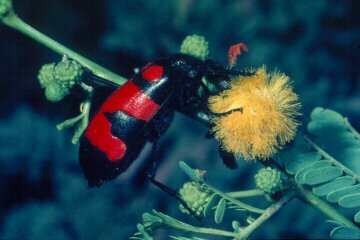Blister beetles - Meloidae
The larvae of the blister beetles look very different in different life stages. The first instar (larval stage) is usually actively predatory and the following instars are less active and more grub-like. The first larval form usually hunts for a pod of grasshopper eggs. On finding the grasshopper eggs, the larva burrows underground and start feeding on the eggs. The larvae moulds and change shape, and continue feeding on the grasshopper eggs. The larva soon forms a pupa, metamorphoses and develops into the adult beetle. The length of the life stages varies according to climatic conditions. Some blister beetles are phytophagous and can become pest in the garden as they feed on flower petals.

Blister beetles, oil or CMR beetles are small to medium sized beetles. They are all brightly coloured in red, yellow, orange, brown or gray with black markings. This colouration signifies a warning of distastefulness or toxicity to potential predators. Some blister beetle species produce a strong chemical substance called cantharadin. Cantharidin blisters the skin and is very poisonous it may cause kidney damage or even cause death when taken in orally. Adult blister beetles are pests in the garden. They feed on the petals of roses, dahlias, other garden flowers, beans and peaches. The larvae however, feed on the egg pods of locusts and grasshoppers and are therefore beneficial to the gardener.
Blister beetle (Meloidae) poisoning can cause death!
The following article is intended for educational purposes only. Never attempt to treat a life-threatening toxicosis (i.e. poisoning due to intake of a toxic substance) yourself. If you believe a human or an animal is suffering from toxicosis, seek the advice of a qualified doctor or veterinarian.
Blister beetles (Meloidae) of the genus Mylabris are widespread and commonally encountered in South Africa, and are of agricultural and medical importance. These beetles are beneficial in the larval stage of their life cycle as they feed on locust eggs. The adults are often seen in the summer months, feeding on the leaves and flowers of crop plants, such as peas and beans. Their damage to the flowers prevent pod formation resulting in economic losses to farmers.
Blister beetles are large, between 20 50 mm in length, and are very conspicuous due to their warning colouration. There are many different species in southern Africa, but the most frequently encountered ones are the larger CMR beetles, named after the Cape Mounted Rifles. These beetles are brightly coloured in yellow and black to warn predators that they are poisonous, this is known as aposematic or warning colouration. Of specific relevance to farmers and humans, is that these beetles produce cantharadin a substance which is so poisonous that it blisters the skin and can even cause the death of animals and humans!
Blister beetles are also found on alfalfa hay fields during the flowering season where they feed on pollen and flowers. Modern agricultural practices of cutting, crimping and swathing in one pass over fields creates a greater risk for subsequent intake and intoxication, as the beetles have less chance of escaping. Poisoning occurs when the animals ingest hay containing blister beetles. Dead and dry beetles are just as poisonous as living beetles. Hence, cantharadin poisoning is common with horses in the USA, but sheep, cattle and goats are also occasionally poisoned.
The poison cantharadin is produced in the haemolymph (blood) of the insect and male beetles produce more cantharadin than females. Male beetles can also transfer cantharadin to females during mating. About one to five percent of the beetles dry weight can contain cantharadin. Thus, the toxicity of dry beetles varies due to the different levels of cantharidin per beetle. If approximately 4 6 grams of dried beetle is ingested, this dose could be fatal. The minimum lethal dose for a horse appears to be less than one mg/kg of body mass.
The onset and duration of symptoms varies from only a few hours to days. Shock and death result when large doses of cantharadin are ingested. If only a few blister beetles are ingested, the symptoms of cantharidin poisoning includes the following:
|
· Colic |
· Anorexia |
|
· Depression |
· Sweating |
|
· Ulceration of the oral mucous membrane (sores in the mouth) |
· Increased respiratory and heart rates |
|
· Fever |
· Soft stools |
|
· Stiff muscles |
· Short-stridden gait |
|
· Collapse |
· Prostration |
|
· Dehydration |
· Abdominal pain |
There is no specific antidote for cantharadin poisoning. Treatment should focus on removing the cantharadin to reduce its absorption and treatment of specific symptoms. The effects of canthardine can be reduced through activated charcoal and mineral oil, and by flushing the body with fluids, especially water to correct dehydration and to promote diuresis. Exposure to cantharadin can be reduced by checking and removing blister beetle infected feeds from animals.
Cantharadin poisoning is serious and fatal if left untreated, thus it is important to make sure that animal feed does not contain blister beetles, or that people, especially young children, do not handle, chew on, swallow, or eat blister beetles.
Once again, the following article is intended for educational purposes only. Never attempt to treat a life-threatening toxicosis (i.e. poisoning due to intake of a toxic substance) yourself. If you believe a human or an animal is suffering from toxicosis, seek the advice of a qualified veterinarian or doctor.
Article compiled by Mrs Carina Malherbe and Mr James Harrison from the Transvaal Museum, Northern Flagship Institution, . Tel: ; Fax